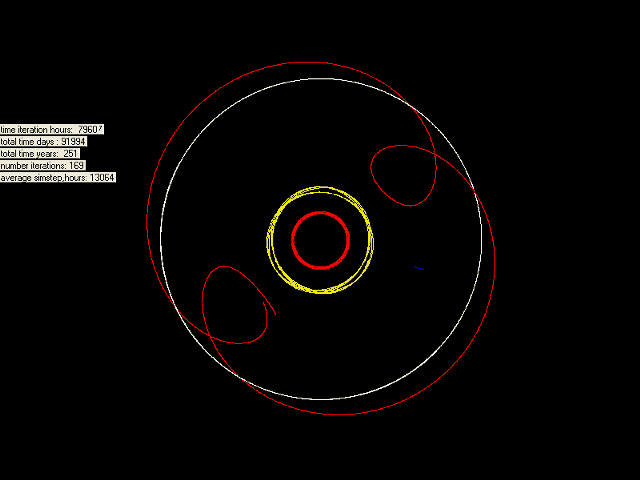
55576 Amycus
Encyclopedia
55576 Amycus provisionally known
as 2002 GB10, is a centaur discovered on April 8, 2002, by the NEAT
at Palomar
.
55576 Amycus was named for Amycus
, a male centaur
in Greek mythology
.
It came to perihelion
in February 2003.
Data from the Spitzer Space Telescope
gave a diameter of 76.3 ± 12.5 km.
A low probability asteroid occultation of star UCAC2 17967364 with an apparent magnitude
of +13.8 was possible on February 11, 2009.
of the 3:4 resonance
of Uranus and is estimated to have a long orbital half-life of about 11.1 Myr
.
It has been observed 76 times over 19 years and has an orbit quality code of 2.

Provisional designation in astronomy
Provisional designation in astronomy is the naming convention applied to astronomical objects immediately following their discovery. The provisional designation is usually superseded by a permanent designation once a reliable orbit has been calculated...
as 2002 GB10, is a centaur discovered on April 8, 2002, by the NEAT
Near Earth Asteroid Tracking
Near-Earth Asteroid Tracking is a program run by NASA and Jet Propulsion Laboratory to discover near-Earth objects. The NEAT project began in December 1995 and ran until April 2007.-History:...
at Palomar
Palomar Observatory
Palomar Observatory is a privately owned observatory located in San Diego County, California, southeast of Pasadena's Mount Wilson Observatory, in the Palomar Mountain Range. At approximately elevation, it is owned and operated by the California Institute of Technology...
.
55576 Amycus was named for Amycus
Amycus (centaur)
In Greek mythology, Amycus was a centaur. He was the son of Ophion and attended Pirithous's wedding. He fought against the Lapiths and was ultimately killed by Pelates. The minor planet 55576 Amycus is named after this centaur....
, a male centaur
Centaur
In Greek mythology, a centaur or hippocentaur is a member of a composite race of creatures, part human and part horse...
in Greek mythology
Greek mythology
Greek mythology is the body of myths and legends belonging to the ancient Greeks, concerning their gods and heroes, the nature of the world, and the origins and significance of their own cult and ritual practices. They were a part of religion in ancient Greece...
.
It came to perihelion
Apsis
An apsis , plural apsides , is the point of greatest or least distance of a body from one of the foci of its elliptical orbit. In modern celestial mechanics this focus is also the center of attraction, which is usually the center of mass of the system...
in February 2003.
Data from the Spitzer Space Telescope
Spitzer Space Telescope
The Spitzer Space Telescope , formerly the Space Infrared Telescope Facility is an infrared space observatory launched in 2003...
gave a diameter of 76.3 ± 12.5 km.
A low probability asteroid occultation of star UCAC2 17967364 with an apparent magnitude
Apparent magnitude
The apparent magnitude of a celestial body is a measure of its brightness as seen by an observer on Earth, adjusted to the value it would have in the absence of the atmosphere...
of +13.8 was possible on February 11, 2009.
Near 3:4 resonance of Uranus
Amycus (2002 GB10) lies within 0.009 AUAstronomical unit
An astronomical unit is a unit of length equal to about or approximately the mean Earth–Sun distance....
of the 3:4 resonance
Orbital resonance
In celestial mechanics, an orbital resonance occurs when two orbiting bodies exert a regular, periodic gravitational influence on each other, usually due to their orbital periods being related by a ratio of two small integers. Orbital resonances greatly enhance the mutual gravitational influence of...
of Uranus and is estimated to have a long orbital half-life of about 11.1 Myr
Myr
The symbol myr was formerly used in English-language geology, and remains as the standard usage in astronomy, as a unit of one million years.It is an abbreviation for 'million years' and lower case is used in geology, while upper case is used in astronomy....
.
It has been observed 76 times over 19 years and has an orbit quality code of 2.

External links
- Orbital simulation from JPL (Java) / Horizons Ephemeris
Wiki links
- List of Solar System objects by size

